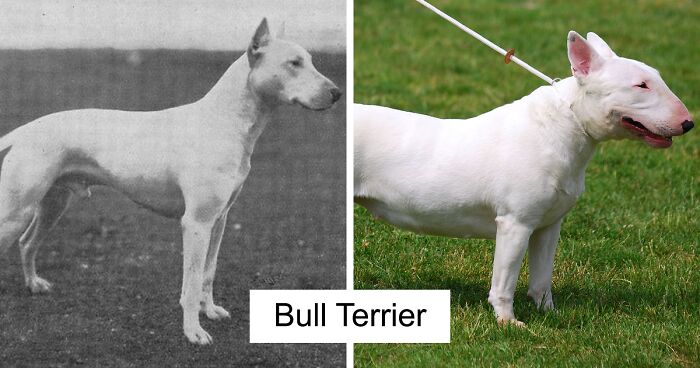Dogs have been around humans for over 30,000 years and have earned themselves the title of humans’ best friends. Since being domesticated, the species has undergone dramatic changes due to selective breeding. People have bred dogs for their advantage, sometimes causing the animals severe health problems. However, only in the 20th century did the selective breeding of dogs become more sophisticated as new methods were discovered.
What Is Selective Breeding, and When Did It Start?
Selective breeding means selecting the species with desirable traits for breeding to increase those qualities in a population. This is usually done to benefit humans and might not always be favorable to the particular animal in its natural environment.
Some of the earliest examples of selective breeding can be found more than 9,000 years ago in Mesoamerica. Humans used to breed teosinte plants, which had a large number of kernels, and this gave rise to corn.
Why Did Humans Start Selectively Breeding Dogs?
It is believed that when humans shifted toward agricultural societies, they started selectively breeding dogs for a smaller size and more docile behavior. This was done to make living together more comfortable for humans and dogs.
Domestic dogs first emerged as early as 30,000 years ago in Southeast Asia thanks to the selective breeding of wolves. This resulted in over 450 globally recognized dog breeds today.
What Did The Original Dogs Look Like?
Many well-known dog breeds look pretty different from how they did a century ago. We compiled this list of dog evolution comparison pictures with the help of the ‘Dogs of All Nations’ book. Scroll down to see the interesting changes in these dog breeds, and let us know which one surprised you the most.
This post may include affiliate links.
Pugs 100 Years Ago
Pugs before breeding were roughly the same size a century ago. 100 years ago, original pugs had longer legs and noses and a slimmer build. They were bred to have bigger eyes and flatter noses. Unfortunately, this led to malformed and sick pugs with breathing problems and other health issues.
Bull Terrier 100 Years Ago
If you look at the bull terrier before and after, you’ll notice that the face has become shorter, while the jaws and the bridge of the nose have become more prominent. The body shape also became more muscular with shorter legs. This build was created explicitly so the breed could function as a fighting dog during the Victorian era.
Irish Setter
Irish setters were imported from Ireland to Spain. They haven’t changed much over the years. Now, they have a longer and thicker coat colored a rich, mahogany red. They also have a slightly thinner body.
West Highland White Terrier
This adorable dog breed hasn’t changed much. All-white terriers were selectively bred in the 19th century in Poltalloch in Argyll, which led to the development of the West Highland White. The few changes that occurred were their fur becoming a little bit longer and thicker.
The old one looked almost like a Cairn terrier. I have read that Westies, Cairns and Scottish terriers were bred together and the breed of the pup was decided at birth - by its color. Quite hilarious, if you ask any modern dog breeder.
Old English Sheepdog
The Old English sheepdog used to be much shaggier than it is today. Apart from that, this is one of the most consistent dog breeds from 100 years ago.
Basset Hound
There are quite a few recognizable changes to the Basset Hound’s build. The hind legs became shorter, the ears became longer, their face became droopier, and their skin now had more folds.
Dobermann Dog Evolution
This dog was originally bred in Thuringia in 1890 by Louis Dobermann. The Dobermann dog breed has a more slender build than before. Their ears used to be cropped and their tail docked, which is now illegal in many countries. They are also not as aggressive as they were before.
Dachshund
The adorable dachshunds you know today were initially bred to be hunting dogs during the 15th century in Europe. Today, the sausage dogs have a longer face and body. Also, a chest that’s slightly wider and hind leggies that are shorter.
Longer body and shorter legs. In other words, more health issues.
Newfoundland
While they appear similar, Newfoundlands were likely much smaller than they are today. ‘Dogs of All Nations’ writes that the breed weighed around 100 pounds in 1915, whereas Newfoundland males can weigh up to 150 pounds today. With so much shaggy fur, you can make different hairstyles for your Newfoundland!
Fun fact: In Disney's 1953 Peter Pan, Nana is a Newfoundland. At the time they were often used as "babysitters" because they're so gentle, but protective of their family.
German Shepherd Dog Breeds 100 Years Ago
German shepherd puppies and dogs have become larger. Their fur has also become longer and thicker. Their skeletons have changed, and their chests are now wider. Studies have shown that these dogs are predisposed to health conditions like arthritis because of how they have been bred in recent decades.
I hate that modern ones' back legs have been tailored to make them appear crouching and cowed.
Scottish Terrier
The coat of the Scottish terrier is now much longer, softer, and has a slightly different texture. 100 years ago, their coat used to be more wiry.
Airedale Terrier
These sporting and playful dogs haven’t changed much over the years. They have a shaggier coat and a longer face with more fur. These dogs are considered to be the largest of all terriers.
Rottweiler
There have been quite a few physical changes in the Rottweiler breed. They have a shorter snout, a more robust jaw, and a different head shape. They also don't have a docked tail anymore, and their coat is now coarser than it was before.
Shetland Sheepdog
Although the Shetland Sheepdog is considered a tiny dog, it has doubled in size over the years. Its fur also became longer to help it cope and survive harsh weather conditions.
But... they're tiny NOW, how have they been even smaller back then?
Boxer Breed 100 Years Ago
Boxers are the weirdest and most adorable dogs because of their energetic personalities. This breed emerged due to the selective breeding of smaller Mastiff breeds and bulldogs. Their original body shape was altered, while their faces, which used to be longer, are more downturned.
Great Dane
Great Danes are huge! These long-legged dogs used to weigh less than they do today. According to “Dogs of All Nations,” they used to weigh around 120 pounds, while today, males can reach up to 175 pounds. They also used to be used as hunting dogs.
Again with weaker headquarters and back and now a squarer, more jowly jaw
Chow Chow
These adorable fluff balls weighed around 50 pounds a century ago. Today, they weigh up to 75 pounds. In addition to this, the faces of Chow Chows have become more wrinkly. Humans bred the Chow Chow with thicker coats to be better suited for work in the snow.
Saluki
The Salukis have become even taller than they were before. Today, they are also thinner, with longer ears and legs. These dogs love companionship and enjoy being around people.
Which Selective Breeding Example Shocked You the Most?
Seeing how popular dog breeds have transformed over 100 years is fascinating. Although selective breeding has added many great qualities, it has complex harmful effects on some dog’s health. That’s why it is crucial not to encourage breeders to cut corners due to high demand. The best way to keep dogs safe and healthy in the long run is to adopt, not shop.
I'm glad the cutting of tails and ears is no longer in fashion/allowed!
Sadly enough, there are enough countries that still do it.
Load More Replies...I despise breeders that have handicapped animals only for their personal glory and money. They don't respect or love animals. The real ugly creatures are this race of breeders.
that's probably the only logical ultimate goal of any pure breed since it relies on inbreeding... with no genetic variety the breed will keep deteriorating
Load More Replies...Feel like this was written by someone that doesn't know what she is talking about. Some breeds have changed drasticly, which is not mentioned in this artical. Shame, could be so much more interesting.
"The ears look slightly different" under the Dobermann, and "tail got longer" under the Rottweiler 😂 She thinks it's a natural change?!
Load More Replies...I'm glad the cutting of tails and ears is no longer in fashion/allowed!
Sadly enough, there are enough countries that still do it.
Load More Replies...I despise breeders that have handicapped animals only for their personal glory and money. They don't respect or love animals. The real ugly creatures are this race of breeders.
that's probably the only logical ultimate goal of any pure breed since it relies on inbreeding... with no genetic variety the breed will keep deteriorating
Load More Replies...Feel like this was written by someone that doesn't know what she is talking about. Some breeds have changed drasticly, which is not mentioned in this artical. Shame, could be so much more interesting.
"The ears look slightly different" under the Dobermann, and "tail got longer" under the Rottweiler 😂 She thinks it's a natural change?!
Load More Replies...
 Dark Mode
Dark Mode 

 No fees, cancel anytime
No fees, cancel anytime 




















































































